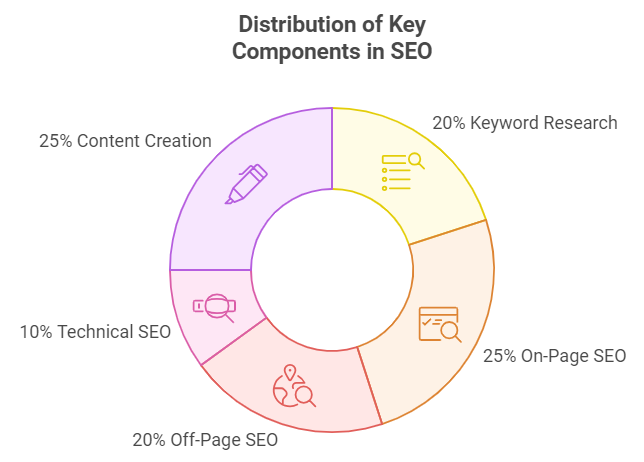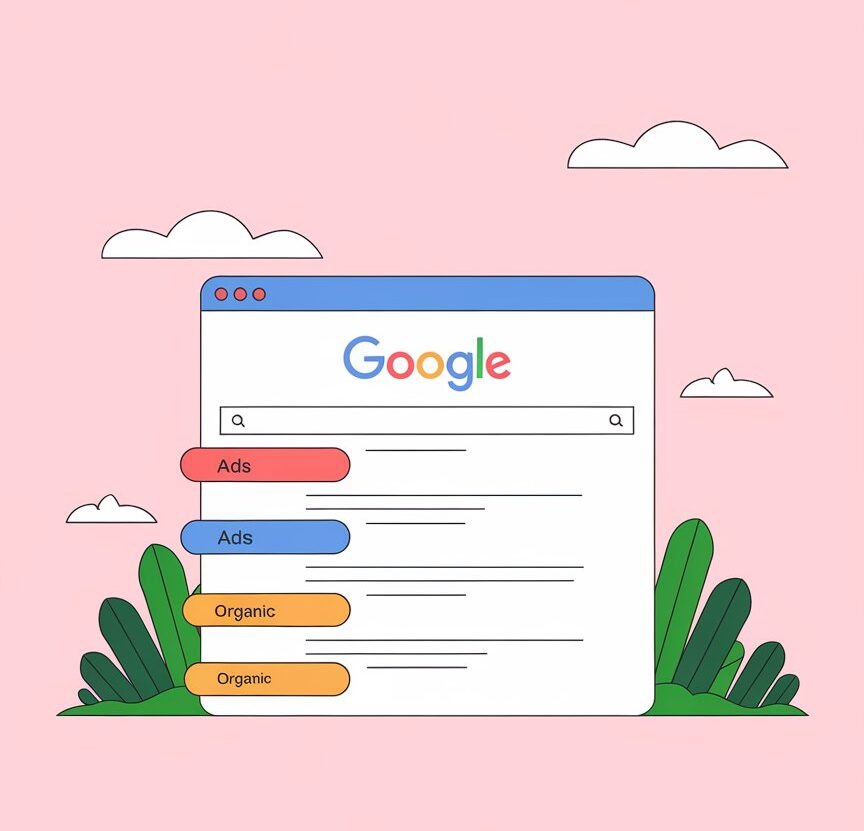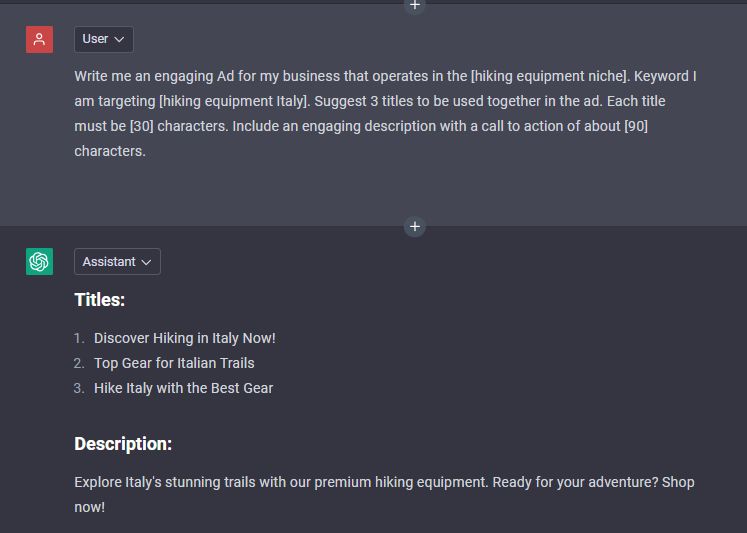In this post, you will learn about two important parts of online marketing: SEO and SEM.
SEO (Search Engine Optimization) helps improve your website’s visibility in organic search results, making your site more visible and easier to find for specific keywords.
SEM (Search Engine Marketing) puts your website in the search results via paid ads like PPC (pay per click), to get your site seen on search engines right away.
SEO helps your site grow steadily over time, while PPC brings quick traffic.
Using both strategies together can help your business grow now and in the future.
This post will help you understand the differences between SEO and SEM and how to use them to get more people to visit your website.
SEO vs SEM: Key Differences
Here’s a simple yet detailed comparison table for SEO and SEM for those of you who are in a hurry:
| SEO (Search Engine Optimization) | SEM (Search Engine Marketing) | |
|---|---|---|
| Definition | The process of optimizing your website to rank higher in search engine results, increasing organic traffic. | A digital marketing strategy used to increase visibility in search engines, involving paid advertisements. |
| Cost | Generally more cost-effective in the long run. Requires an investment of time and resources. | Can be costly as it involves paying for ad space. The cost can vary based on competition. |
| Visibility | Improves organic search visibility. It may take time to see results. | Provides immediate visibility. Your website can appear at the top of search results as long as you’re willing to pay. |
| Sustainability | Long-term strategy. Once achieved, rankings can sustain for a longer period. | Short-term strategy. Visibility lasts as long as you’re paying for it. |
| Tactics | Keyword optimization, quality content creation, backlinking, etc. | Pay-per-click (PPC) advertising, keyword research, ad copywriting, etc. |
| Impact | Builds trust and credibility over time. | Can quickly drive traffic, but may not build the same level of trust. |
What is SEO?
SEO, or Search Engine Optimization, is the process of optimizing your website to rank higher in the search engine results pages – also known as SERPs.
The primary goal of SEO is to increase organic (non-paid) traffic to a website by making it more appealing to search engines and users alike. The more traffic you get to your website, the more leads and sales your get.
SEO, involves a combination of technical adjustments, content creation, backlinks and strategic planning.

SEO is considered “better than SEM” because most people click on those organic results, not the ads. They also tend to “trust” more something that appears organic, rather than an advertisement. So by focusing on SEO, you’re setting yourself up for long-term success without the ongoing cost of advertising.
Core Components of SEO
Now, in order to make your website “shine” in search engine results, you need to get a handle on a few crucial aspects of SEO.
- Keyword Research: First up, let’s talk about keyword research. This is all about figuring out what words and phrases your audience is typing into search engines and the ones you are going to target. Once you know that, you can tailor your content to match them.
- On-page SEO: Next, there’s on-page SEO. This is where you ensure that your content isn’t only high-quality but also relevant to those keywords you’ve researched. It’s about making sure that when someone lands on your page, they find exactly what they were looking for.
- Off-page SEO: Off-page SEO is any action you perform outside of your website. For example, building your website’s reputation by sending press releaes and getting mentioned in other publicaitons or getting links from other sites. Links (or backlinks) is like getting a recommendation from a friend; it makes you seem more trustworthy and authoritative in the search engines’ eyes.
- Technical SEO: Let’s, don’t forget about technical SEO. This is the behind-the-scenes work on your website that is a bit technical. Most of the times, you’ll need a web developer to perform them. Of course, you can do them as well, if you are willing to learn. Technical SEO involves, keeping your site’s speed fast, fixing errors, updating meta tags on your website, structuring the website in a way for search engine “spiders” are easier to crawl and stuff like that.
- Content Creation: High-quality, relevant content is essential for SEO. Regularly updating your website with fresh content can help improve rankings and engage users. To keep things simple think of it this way: The more pages you have indexed on the search engines, the more chances you have to get found by potential clients. If you have 5 pages, you have 5 chances. If you have 500 pages, you have 100X more chances

How Much Does SEO Cost?
So, how much does SEO cost? Well, it can either take up a lot of your time or a lot of your money, depending on how you approach it.
Allow me to explain myself:
Keyword Research
First, let’s talk about keyword research.
- You’ll need to invest a good chunk of time into finding the right keywords to rank for. For example 2 hours.
- If you subscribe to a keyword research tool your monthly cost will be something between $20 – $80.
- You can outsource this tasks to someone on Fiverr for $5 – $25 – once off.
How important Keyword research is? Let’s say that if you end up writing articles that never rank, you’ll feel discouraged and might even give up.
Content Creation
Next up is content creation. Once you’ve got your keywords, you need to create content targeting them. Whether you’re focusing on local SEO or not, content is key.
- You first option is to write the content yourself – the old fashioned way. Research competition, understand what your audience wants to learn and write a better article around your audience’s query. The whole process might take you between 4 and 6 hours.
- If you don’t have the 4 – 6 hours for writing an article, these days, you can use an AI writing assistant like Koala writer to speed things up, but if you want your content to rank well (especially in English), you’ll still need to spend around 2 hours per post optimizing and formatting.
- Again, if you don’t have that kind of time, you can outsource it on freelance websites like Fiverr for $30 – $100 per article. Then there’s publishing and styling your content on your CMS, which also takes time as well. Outsourcing this task means spending more money per article published.
Backlinks
Let’s not forget about backlinks. No matter how much SEO changes, backlinks remain a ranking factor. If someone says that they don’t play role in SEO, then stay away..
You have three options when it comes to backlinks for SEO:
You can either wait for them to come naturally (which they probably won’t)
- Build them yourself. This involves finding and communicating with webmasters for a guest post, creating the content, and submitting it. If you’re lucky and don’t have to pay, the process will only cost you time. But if you don’t have the time, you’ll need to outsource this task as well – which means spending even more money.
If you are looking for backlinks, contact me. I can help.
On-page optimization
Lastly, there’s on-page SEO. Remember the content you published? Your images and metadata need optimization. If you haven’t done this already, it’ll take more time, or if you outsource, more money.
Again, your options are something like this:
- Do it yourself: Spend many (many hours) but don’t spend a dime.
- Outsource it: Hire an SEO to do it for you.
P.S: The same goes for Technical SEO as well. You can either spend many hours fixing stuff yourself or hire someone to do them for you.
Here’s a breakdown of the time and costs involved:
| SEO Task | Time Cost | Money Cost |
|---|---|---|
| Keyword Research | 2 hours | $xx per month (Keyword Research Tool) |
| Content Creation | 2 hours per post (with an AI writer) | $25 per month (AI writer) |
| Publishing, Styling, Sharing on Social Media | 1 hour | $20 – $30 per hour (outsourcing) |
| On-page Optimization | 30 minutes per post | $10 – $15 (based on $20 – $30 per hour) |
| Building Backlinks | 4 hours per backlink (estimated, includes research, outreach, content creation and submission). You’ll likely get links from “weaker” websites that are looking for free content instead of strong websites that can actually move the needle)=. | $50 to $500 per post; up to $2500 for a backlink from a large publication, plus SEO fees |
As you can see, SEO can be a significant investment, whether you’re spending your own time or your hard-earned cash. But with persistence and the right strategy, it can pay off in the long run.
What is SEM & PPC?
Now, let’s see what Search Engine Marketing, or SEM for short, is and how it compares to SEO.
SEM is a way to promote your website / services to the search results (SERPs) using paid ads instead of waiting to rank organically. These paid ads are called Pay Per Click or PPC for short. They’re called this way because you literally pay for every click you get back to your website.
When you use a search engine, the results you see at the top are often paid advertisements. That’s SEM in action.

Here’s how it works:
- First, you decide who you want to reach. With SEM, you can be very specific about your audience. For instance, if you sell hiking gear, you can target people who are actively looking for hiking equipment online. In fact you can target this specific keyword “hiking equipment + [city or country you ship to]”
- Next, by using SEM, you can connect with potential customers at the exact moment they’re searching for what you offer. This is crucial because it means you can catch their attention when they’re most likely to make a purchase.
- Then, because SEM is data-driven, you can see how well your ads are performing in real-time. You’re free to adjust your strategy on the go, depending on what’s working and what’s not. This way, you can make sure you’re getting the most out of your investment.
- In the end, if you use SEM effectively, you can achieve measurable results, like increased traffic to your website and more sales. It’s a powerful tool for growing your business online.
Core Components of SEM
Search Engine Marketing (SEM) is a powerful way to promote your business online. To make the most of it, you need to grasp a few essential elements.
- Keyword Research: First, you start with keyword research. This is all about finding the right words or phrases that people are using to search for products or services like yours. Google’s keyword planner works just fine for your research. By targeting these keywords, you can get your ads in front of the right people.
- Creating the ads: Next, you move on to creating the ads themselves via Google’s or Bing’s ads platforms. This is where you write engaging and persuasive content that encourages people to click on your ad. Nowadays, Google ads have integrated Ai that “suggest” ad copy. You can even use any free Ai writing assistant.
Just give it this prompt:
Write me an engaging Ad for my business that operates in the [hiking equipment niche]. Keyword I am targeting is [this]. Suggest 3 titles to be used together in the ad. Each title must be [30] characters. Include an engaging description with a call to action of about [90] characters.
- Bidding: Once your ads are ready, the next step is to manage your bids. This means deciding how much you’re willing to pay for each click on your ad. The goal here is to find a sweet spot where you’re getting your ads seen by a lot of people without spending too much money.
- Tracking Performance: After your ads are up and running, you need to keep an eye on how they’re doing. This is the performance tracking phase. By looking at the data, you can see what’s working and what’s not. This way, you can make informed decisions to tweak your ads and get even better results over time.
How Much Does SEM Cost?
To figure out how much SEM will cost, you need to look at a few key factors.
- First, how competitive is your industry?
- Second, how big do you want your campaign to be?
- And of course, what kind of advertising budget are you working with?
For most small sized companies, you can expect to spend anywhere from $500 to $1500 each month. This covers not just the ads themselves, but also agency fees for managing the campaign.
However, this is just a rough estimate. The actual cost can change quite a bit depending on your specific market and how many other companies you’re competing with.
For example, if you’re in a field like law or finance, you may need to invest more money to get the results you want.
To get the most out of your SEM campaign, you’ll need to keep a close eye on how it’s performing. By regularly checking the data and making adjustments as needed, you can make sure you’re getting the best possible return on your investment.
When to use SEO and When to Use SEM?
So, when should you use SEO and when should you use SEM? Well, in my opinion you should start with SEM and then move to SEO.
Starting with SEM is a good idea for most businesses because you can start getting leads right away, which is great for your business’ viability.
But, you should also invest in SEO. Now, SEO takes a bit longer to show results – we’re talking around 6 months – but once those results start pouring in, they’re often more powerful than SEM.
According to HubSpot, SEO has a conversion rate of 14.6%, while SEM has an average conversion rate of only 2.35%
You might be thinking, “But isn’t SEO free?” Well, theoretically, yes. It needs time rather than money. But let’s be real, not all of us are authors with tons of time to write SEO-optimized content, do keyword research, check out competitors, and build backlinks.
So, you might end up paying someone to do all that for you, which could cost around $500+ per month. That’s about $6K per year. So, in a way, both SEO and SEM cost money.
So, to summarize, if you want leads fast, go with SEM. If you’re a blogger or a bootstrapped business with no marketing budget, and you’re willing to put in the time and effort to learn and produce content yourself and build backlinks, then SEO is your solution.
Remember, you don’t have to choose between them. Using both can give your business the best of both worlds – quick leads from SEM and long-term, high-converting leads from SEO.
Conclusion
Now that you’ve grasped the essentials of SEO and SEM, it’s time to take action.
Whether you’re aiming for the organic growth that SEO promises or the quick wins of SEM, keep in mind that a well-rounded strategy incorporates both.
Dive deeper, experiment with tactics, and keep learning. Your journey to the top of search engine rankings starts now. Let’s make your website not just a destination, but the destination.
👉 Aκολούθησέ με στο Facebook και ενεργοποίησε τις ειδοποιήσεις για να λαμβάνεις τα νέα άρθρα μου.
